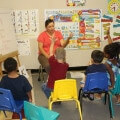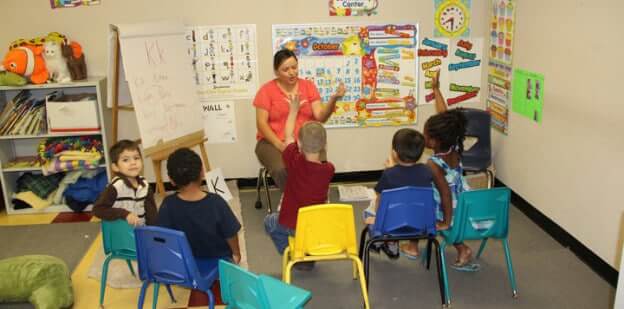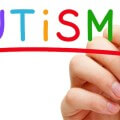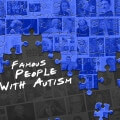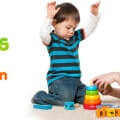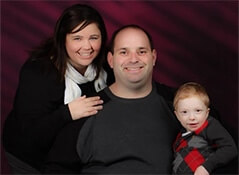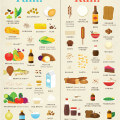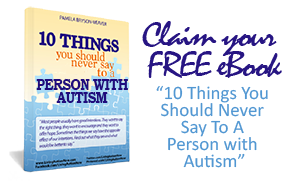TRUST ~~~ WHEN YOU CAN TRUST THE PERSON WHO WROTE A BOOK YOU ARE OF TO A RUNNING START TO BE BLESSED! When that person knows the subject that they are not only putting into words, but have already paid the price for the information being shared – you will also be enriched by what you read. HOPE ~ There is always a need and a source for HOPE> Pamela knows how to reach out with her words to do just that: H- helping O- other P- people E – endure. In fact, with the Lord’s guidance she does more than just help folks dealing with this heath challenge to ‘endure’ but be overcomes!
Tag Archives: autism
M. Brooks
The author delivers the most intimate truths about her life in the most genuine way. She sheds a light on the highs as well as the lows. I believe this book will not only benefit the families living directly with autism but also those on the outside; such as myself. It has helped me to have a better understanding of the inner life of autism. She has brought a guide that can be used for all to cope, understand, and learn while keeping it simplistic in terminology and personal so we can empathize with the emotions. I highly recommend this book to anyone as it has the ability to help you find hope and gratitude. Well done!
Dad of Divas (www. dadofdivas.com)
While I do not live with autism daily, this was an interesting read. I appreciated how in-depth the author was in regards to what parents have to deal with in an honest, upfront and truthful manner. The book was easy to understand and the author talks to you as if you are a trusted friend. That being said I was very impressed with the amount of information that was shared and I can honestly say that I learned SO much from reading this that I was not aware of previous to reading. The book is definitely a resource that will offer hope and resources for anyone touched by autism. The daily reflections really make you think differently about autism and what this means to you and the people around you!
*I received this for review – all opinions are my own*
Kelly
When I received Pamela Bryson-Weaver’s Living Autism day-by-day, I knew that it would be of interest to several moms that I know.
It begins with an informational intro, then transitions into a journal of sorts. Each day has a story, quote, and /or info, and has a space for notes or reflections. It’s a great hybrid of clinical information and lovely thoughts and quotes. I thought it would be a great resource and personal notebook for the parent of an ASD child.
I gave the book to a friend and asked for her review, as someone who is very knowledgeable on the subject and truly is living autism day-by-day. Below are her thoughts:
“I appreciate Mrs Bryson-Weaver’s positive breath of fresh air on a variety of topics that are very difficult for most parents of an ASD child. Daily she provides a famous inspirational quote, a topic to revel over, and a small daily objective to strive for. She covers advocating for the ASD child as well as advocating for yourself to find the answers you seek, the support you need, and acceptance of your child for who they are.
Her knowledge and suggestions are current in terms of biomedical and dietary treatment approaches. I’m not so sure that all of her ideas are reasonable though. As a mother myself of a child with an ASD, I was quite surprised to find her “home schooling” suggestion.
On a whole, the book is a must read for parents of a newly diagnosed child!!”
Understanding Autism Spectrum Disorders
Autism is a wide spectrum of disorders that overlap among each other yet, has distinct characteristics making each case unique even among siblings. Collectively, they are called Autism Spectrum Disorders (ASD). Any of these disorders can affect both children and adults. Currently, it has NO known cures. They are also genetic in nature. According to recent data from CDC, this developmental disorder affects 1 out of every 68 children in the US alone. Though it is known to affect more boys than girls, grouping together a child’s symptoms can be tough. To understand ASD better, here are some basic markers to consider:
Autistic Disorder
Simply referred to as “autism,” it is also recently being described as “mind-blindness” or the lack of Theory of Mind creating major barriers in communication and socialization. This collection of neurological and developmental disorders is usually diagnosed in the first 3 years of life. A child with autistic disorder engages in repetitive behaviors, appears to have a world of his own, shows little or no interest in others, and has obvious lack of social awareness. A child with autism is often focused on consistent routine with interest transfixed in repetitively odd or peculiar behavior. Almost always, children with autism have communication issues, avoid direct eye contact, and manifests limited attachment to others.
Regressive Autism Spectrum Disorder
Regressive ASD is sometimes referred to as autistic regression or autism with regression, or acquired autistic syndrome and setback-type autism. It usually occurs when a seemingly normal child starts to lose speech and social skills from 15-30 months of age. Amid researches and studies done over the years, however, there is still no definite distinction between autism with- and without regression. Some believe that this type of autism is just an early-onset autism diagnosed at a later date. Some features early delays while others are diagnosed after later losses. This is believed to affect approximately 20-30% of children in the spectrum.
Pervasive Developmental Disorder – Not Otherwise Specified (PDD-NOS)
Called PDD-NOS or atypical personality development, this type of autism refers to the “sub-threshold” condition wherein some, but not all, features of ASD or other explicitly identified PDD are identified in a child. PDD-NOS is a diagnosis which covers cases marking impairment of communication, social interaction, stereotyped behavioral patterns and interest—but does not include autism’s full features or explicitly defined pervasive personality disorder/PDD. Take note that most of those in PDD-NOS have less impaired social skills than those in “classical” autism.
Asperger’s Syndrome
Also known simply as Asperger’s or Asperger Disorder, this ASD is usually diagnosed between the ages 2-6. A child with Asperger’s manifests good verbal skills and good cognitive skills but is rather clumsy, socially awkward, and often engages in odd, repetitive behaviors and interests. This is named after Austrian pediatrician, Hans Asperger, who conducted a study on a group of children in 1944.
Childhood Disintegrative Disorder
Known as Heller’s syndrome or disintegrative psychosis, this type of ASD is very rare. Children with seemingly normal development suddenly lose motor, social, and language skills around the ages 2 to 4. This severe regression usually presents a dramatic loss of skills and can develop later than autism does.
Rett Syndrome
Coined after Dr. Andreas Rett’s study, Rett’s Syndrome or Rett’s Disorder is a condition that used to be called cerebroatrophic hyperammonemia. This is an extreme form of ASD characterized by zero verbal skills with 50% not being able to walk. Most of those who have Rett’s have small hands and feet, with notable deceleration of head growth, repetitive stereotypical hand movements, and some 80% experience seizures. Scoliosis, growth failure, and other gastrointestinal disorders are also common for children with Rett’s Syndrome. Almost all of the cases reported under this spectrum occur in girls, but studies reveal that this can also affect boys.
As more and more research is being conducted on Autism Spectrum Disorders, we can only surmise that more type of autism will come out soon. Geneticists recently pointed out that the right term to be used is “autisms”(plural) rather than “autism” due to the variety of genetic forms the developmental disorder represents.
When diagnosing Autism, parents should seek professional diagnoses from specially trained professional, including pediatricians, psychologists, and others. List can be found at http://livingautismnow.com/directory/ for Canada, http://www.autism.org.uk/directory.aspx for the UK, and http://www.autism-society.org/ for the US.
Pamela Bryson-Weaver is the author of Living Autism Day by Day: Daily Reflections and Strategies to Give You Hope and Courage, a #1 bestseller on amazon.com. A staunch advocate for autism, she is also the mind behind the powerful website—www.livingautismnow.com—an online portal for parents, caregivers, individuals with ASD, service providers, and experts to interact with each other, to raise awareness, and locate the best possible services for them. Bryson-Weaver is uniquely qualified to speak on autism as she is the past president of the Autism Society in New Brunswick, and has promoted a resolution on autism that was presented locally, provincially and nationally, and was passed nationally in Canada 2004. To date, all children diagnosed with Autism Spectrum Disorder in her province receive S20k per year for treatment. Married with 3 children, the main driving force in this advocacy is her youngest son, John, who has autism.
Sources:
Children’s Hospital of Wisconsin
WebMD
Livestrong
Yale School of Medicine
7 Ways to Choose the Right School for Your ASD Child
Choosing a school for your child with Autism Spectrum Disorder can be overwhelming. Not only will you be choosing a school that will make your child thrive, you need also to look into its educational values and the overall school’s reputation on how well it accepts Autism. You need to accept the fact that not all schools are as welcoming as they seem to be, no matter how they promote their campuses as such. As a parent to a child who is on the spectrum, it takes a lot of efforts and research to finally found one. To get you started, here are a few things to take note when shopping for a new haven for your child.
- Scrutinize the different schooling options available. Every child on the spectrum has a different requirement and needs. You need to remember that what could work for another child on ASD might not exactly work for yours.
- Try to browse the net for schools in or near your area. Most schools nowadays are listed online and researching for those located near you can be such a breeze. Make a list of your preferred schools and schedule an appointment.
- Take time to sit and discuss with the school’s representative. During your visit, have a feel on whether the school staff is welcoming and how knowledgeable they are about ASD. It is also important to know if the school has a separate program for students with special needs or if they treat them as equals. Do not forget to check the schools extra-curricular programs. Some schools, especially with active Autism communities, have after-school programs specifically created to cater to children with developmental disorders. This is one great way to hone your kid’s abilities and to improve his social skills.
- If possible, do your visits on a typical school day where kids are abuzz with activities. School “open house” may prove to be welcoming because it is designed to be so. Try to come on “normal” school days to get the actual picture. When visiting, however, do not take your child with you. You will only be adding to his or her confusion that might become a prelude a dislike of schools.
- If you have done transitioning activities with your autistic child, ask the school staff or the principal if it is okay for him or her to do a “visit.” A few minutes of integration with other kids his age can be helpful but, do not overdo it. Limit it in as much as five to ten minutes. Be keenly observant to avoid any meltdown.
- Schools for kids with developmental disorders can be costly. There are schools though which proactively process application for additional funding to help families living with Autism. Check how their enrollment is usually processed.
- Check the school’s security system. Kids on the spectrum need to be in a secure environment due to their different level of vulnerability. Make sure the school has an iron-clad security system to protect your child with autism from harm, and even from bullying.
Indeed, finding a school with a positive vibe in it, and where children with autism are most welcome can be an arduous task. However, hope springs eternal as more and more schools in Canada are opening up to those living with Autism Spectrum Disorder. In all things else, choose one which you believe will make your child happy.
Teaching Your Community About Autism The Positive Way
Ever experienced having someone’s eyebrows raised over your autistic child?
Do you feel insulted or hurt?
It is a common occurrence among many communities across the globe for people to not instantly understand what your child is going through with this ordeal. However, you, as one who has direct knowledge about Autism Spectrum Disorders, have all the power in your hand to make people understand about it. The challenge is how to do it nicely without offending the other party.
 As we all know, some people that those living in the spectrum are dysfunctional and live in their own world. These observations, however, are but a minute part of the spectrum of disorders that the autism genome carries. If your child or a sibling has ASD, educating those around you can be done in a positive manner. You can start talking to neighbors about it. If you have community forums, joining in one and making your intentions known can also elicit awareness among those who surround your loved one with Autism.
As we all know, some people that those living in the spectrum are dysfunctional and live in their own world. These observations, however, are but a minute part of the spectrum of disorders that the autism genome carries. If your child or a sibling has ASD, educating those around you can be done in a positive manner. You can start talking to neighbors about it. If you have community forums, joining in one and making your intentions known can also elicit awareness among those who surround your loved one with Autism.
Start by educating them on the nature of the disorder, that is, Autism is neurological and not psychological as what others believe it to be. Add the fact that it is a spectrum of disorders meaning, ASDs have different levels of severity and not necessarily like Simon Lynch on Mercury Rising or Dustin Hoffman in Rain Main. Before you do this, it is imperative that you harness your knowledge about the spectrum of disorders that Autism carries to ensure that you get your point across as factually as possible. This could mean researching about your child’s diagnosis, interacting with medical professionals assessing his or her cognitive, language, developmental and social skills, and so on.
It is important to point out the challenging ways like making eye contact, showing appropriate emotions, and other manifestations affecting their social skills. Most kids with autism also has trouble accepting change and when faced with such, they can easily feel stressed and agitated making it hard for them to reach out and be understood. It is like being in the South of France with nary any idea about the language. It is how their brain works and they cannot help it, one puzzle no one has the obvious answer as to why. It is important to let people understand that an autistic’s reaction or lack thereof to certain stimuli is part and parcel of the disorder. Some manifests differently than others but, all the same, this neurological condition can bring in different reactions.
Be as factual as possible in your points. If talking to neighbors or friends, make them understand the diagnosis provided by your child’s doctor and the observations you have gathered over time. Along with facts, your attitude also plays a big role in making people that surrounds your child or sibling with autism understand what you and your child/sibling is going through. Not will this improve their interaction to people with ASDs, this will also increase their awareness and be able to relay this to others. Besides, word of mouth has always been an effective manner of raising awareness.
Photo credit: http://www.4-roads.com/Social/Blog/social-networks-vs-online-communities
Autism ABA Insurance Coverage: A Matter of Time
It has been known that Canada had led the northern pack in terms of finding appropriate treatment and therapy for Autistic Spectrum Disorders. Not only due to strong parental advocacies, the prevalence of tight-based community support systems also make Autism programs across many Canadian provinces to widen the scope of Autism health insurance coverage over the years. Yet, many insurance companies continually refuse to cover for ABA (applied behavior analysis) on the basis that it is “educational” or, in some cases filed, “experimental.”
As we all know, the effectiveness of ABA-based intervention on children with ASDs has been well documented for the last 5 decades or so. According to the American Academy of Pediatrics, children receiving early intensive ABA treatment have greatly shown substantial and sustainable gains not just in language and ID but also on academic performance, adaptive behavior and social conduct. Children with ASDs treated with ABA are also significantly better than those in control groups.
In a nutshell, ABA is a behavioral intervention to proactively treat ASDs and it is widely used by medical practitioners and caregivers directly involved in the pursuit to manage, if not to treat, autism. Most of us who have family members with Autism are not that unfamiliar with this therapy. Over the years, however, the insurance industry continually gives ABA the cold treatment as some of us might have also experienced with our private medical insurance. Well, there is hope that such could change nowadays.
With the recent statistics of 1 in 68 children having ASDs publicly declared and current declaration of Dr. Vera Tait, associate executive director of the American Academy of Pediatrics, debunking the “experimental” claims only on ABA, there is hope after all for families dealing with Autism Spectrum Disorder to enjoy a far wider coverage on their medical insurance for Applied Behavioral Analysis. According to Dr. Tait’s testimony before a subcommittee of the Senate Armed Services, a more flexible insurance coverage covering ABA should be afforded to families affected with ASD as the effectiveness of the treatment becomes more prevalent. All one needs is an appropriate diagnosis by a certified physician and declaration of ABA as a medical therapy for the individual with ASDs.
With this breakthrough, the autism communities across the US and, maybe, Canada in the near future will enjoy its positive impact. Not that it can cure ASD but mainly because it can be of great help in providing a more effective habilitative progress among kids with autism leading them to live a life they so rightfully deserve.
How to Manage Autism Meltdowns
There is no boring day to parents with autism kids. The worst days, however, are those that involve a meltdown. Now, that’s what you call a nightmare! One moment your child is perfectly settled on his routine and the next minute, he turns into a Godzilla with no one to block his path. The scary part is that, you have no idea what upsets him or what triggered the reaction.
Not to be confused for temper tantrums, meltdowns can easily turn from bad to worse when parents do not know what to do or how to deal with it. This could be tough to a first-time parent. Thus, equipping oneself with the necessary preparation for that eventual meltdown will help prevent unnecessary circumstances inimical to the welfare of the child and the people surrounding him.
Dissecting Likely Causes
Not to be mistaken for a temper tantrum, children with autism when facing a meltdown can be much tougher to handle. One of most likely causes is sensory, information, and emotional overload. Take note of the word: OVERLOAD. Kids with ASD can only take so much and all things in excess can push their panic button. This overly sensitive characteristics usually trigger their brain to be overwhelmed resulting in panic. Another common cause is sudden changes. Living in the spectrum often makes children live a life filled with routines. They love basking in a life that is filled with predictability. Sudden changes in their environment or in their expectations can easily jolt and tear them apart. Some parents also mentioned that fatigue is another likely cause in some children’s meltdown. As the brain cannot process fatigue or its consequences, this can be intensely frustrating leading to turmoil deep in their core.
Preventing and Managing Meltdowns
As meltdowns can come and go freely to any child with autism, it is imperative for parents to proactively learn how to handle and manage such before it even manifests in actuality. You can discuss management techniques with your paediatrician, caregiver, SpEd teacher, or counselor to give you handy information on how to best approach when this occurs. Be sensitive to their needs. Many said that parents to kids with autism need special powers to know when and what causes a meltdown. Paying special attention to your child won’t hurt. Keeping a timetable and be always on the close guard on what makes them comfortable/uncomfortable to prevent frustration leading to panic.
It is also important to set boundaries with your child. In the same way as toddlers, children living on the spectrum often have meltdowns because they can’t have their own way. If you believe the answer is a “no”, be firm and stand by it. You can choose to ignore it, redirect him to another activity, or infuse discipline by way of simple “punishments” like timeouts or withholding of special treats. Most kids living on the spectrum have high intelligence level. They do understand more than you expect them to be.
Some children, however, are prone to hurting themselves or those around them. Learn the proper way to restrain them and make sure to eliminate possible hazards in your home. You might be surprised how strong or violent these little kids can be up until you have a blackened eye or a bruised leg. For their safety and yours, learn how to address possible hazards ahead of time.
Of Reaching the Top With A Grateful Heart
Fun-freakin’-tastic! Everything is supercalifragilisticexpialidocious! Amidst my broken foot, I was totally overjoyed by the good news that my new book brings. Yes, I made it to the #1 Bestseller in 3 categories on Amazon.ca and #1 International Bestseller on Amazon.com—I would never reach this far without the help and support from family, friends, and people whose lives have been touched by autism.
It’s been a long journey, one that made me grow to be a much better and more grateful person along the way. From writing my book to the hectic days filled with promotions and launches, I was astounded at the capability of people to offer help and support in any way they can to uplift my spirit, to push me to the right direction, to encourage me in my quest of reaching the Bestsellers List, and to propel me to the top.
From emails, phone calls to private messages, there was nary a day passed by that family, friends, autism communities and acquaintances offered the sustenance I need to be hopeful and to maintain a positive mindset. When I reached the #1 Bestsellers List on Amazon.ca and Amazon.com, I could not help but shed tears of joy while my son, Johnny, engulfed me in a big giant hug. He must have understood what I felt right at that moment as he was also misty-eyed and had this huge smile plastered on his handsome face.
There was one glitch during my Amazon book launch though, and that is they failed to place me on the most important category of all—Autism and Asperger’s Syndrome. But all’s well that ends well. I wrote to them and the company responded accordingly. Basically, people searching for books on autism and Asperger’s can now see me on their list, and that’s one thorn plucked from my chest.
To the very people who continually give their support, wisdom, expertise, and thoughtfulness, it is important for you to know that I have come this far because of you. To those who bought my book (even at full price!), my respect and gratitude for the love and care this action brings. My journey to reaching the top was, indeed, toilsome with potholes along the way but being surrounded by such a loving and supportive circle truly made the difference.
I humbly request that you share my book to your friends and family who needed hope and encouragement on what they maybe going through right now. This book is meant to spread awareness and acceptance of Autism as well as in keeping up the faith in facing life’s greatest tribulations, head-on. Let this become your anchor, your guide, and your sustenance when things seem to go haywire.
Going forward, please share to all families you know who are dealing with autism my FREE website www.livingautismnow.com. This particular website is growing globally with the intention of helping families struggling with autism. Every cent from my book has been going to develop and run it.
From the bottom of my heart, my sincerest and warmest gratitude. You are awesome!



